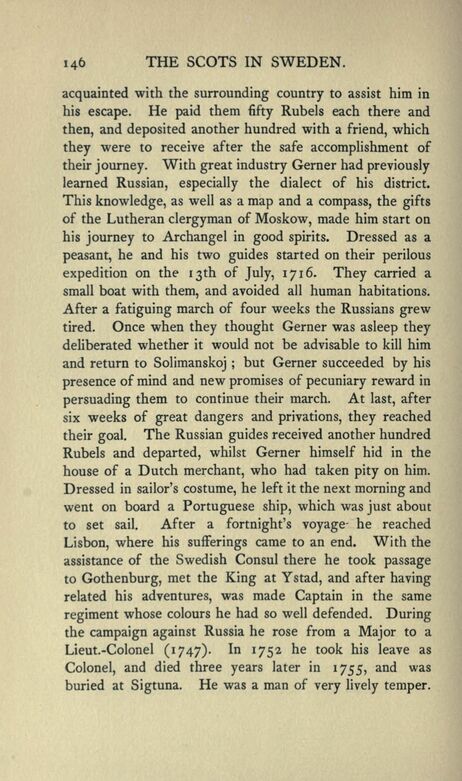
Full resolution (JPEG) - On this page / på denna sida - Sidor ...

<< prev. page << föreg. sida << >> nästa sida >> next page >>
Below is the raw OCR text
from the above scanned image.
Do you see an error? Proofread the page now!
Här nedan syns maskintolkade texten från faksimilbilden ovan.
Ser du något fel? Korrekturläs sidan nu!
This page has never been proofread. / Denna sida har aldrig korrekturlästs.
acquainted with the surrounding country to assist him in
his escape. He paid them fifty Rubels each there and
then, and deposited another hundred with a friend, which
they were to receive after the safe accomplishment of
their journey. With great industry Gerner had previously
learned Russian, especially the dialect of his district.
This knowledge, as well as a map and a compass, the gifts
of the Lutheran clergyman of Moskow, made him start on
his journey to Archangel in good spirits. Dressed as a
peasant, he and his two guides started on their perilous
expedition on the 13th of July, 1716. They carried a
small boat with them, and avoided all human habitations.
After a fatiguing march of four weeks the Russians grew
tired. Once when they thought Gerner was asleep they
deliberated whether it would not be advisable to kill him
and return to Solimanskoj ; but Gerner succeeded by his
presence of mind and new promises of pecuniary reward in
persuading them to continue their march. At last, after
six weeks of great dangers and privations, they reached
their goal. The Russian guides received another hundred
Rubels and departed, whilst Gerner himself hid in the
house of a Dutch merchant, who had taken pity on him.
Dressed in sailor’s costume, he left it the next morning and
went on board a Portuguese ship, which was just about
to set sail. After a fortnight’s voyage- he reached
Lisbon, where his sufferings came to an end. With the
assistance of the Swedish Consul there he took passage
to Gothenburg, met the King at Ystad, and after having
related his adventures, was made Captain in the same
regiment whose colours he had so well defended. During
the campaign against Russia he rose from a Major to a
Lieut.-Colonel (1747). In 1752 he took his leave as
Colonel, and died three years later in 1755, and was
buried at Sigtuna. He was a man of very lively temper.
<< prev. page << föreg. sida << >> nästa sida >> next page >>